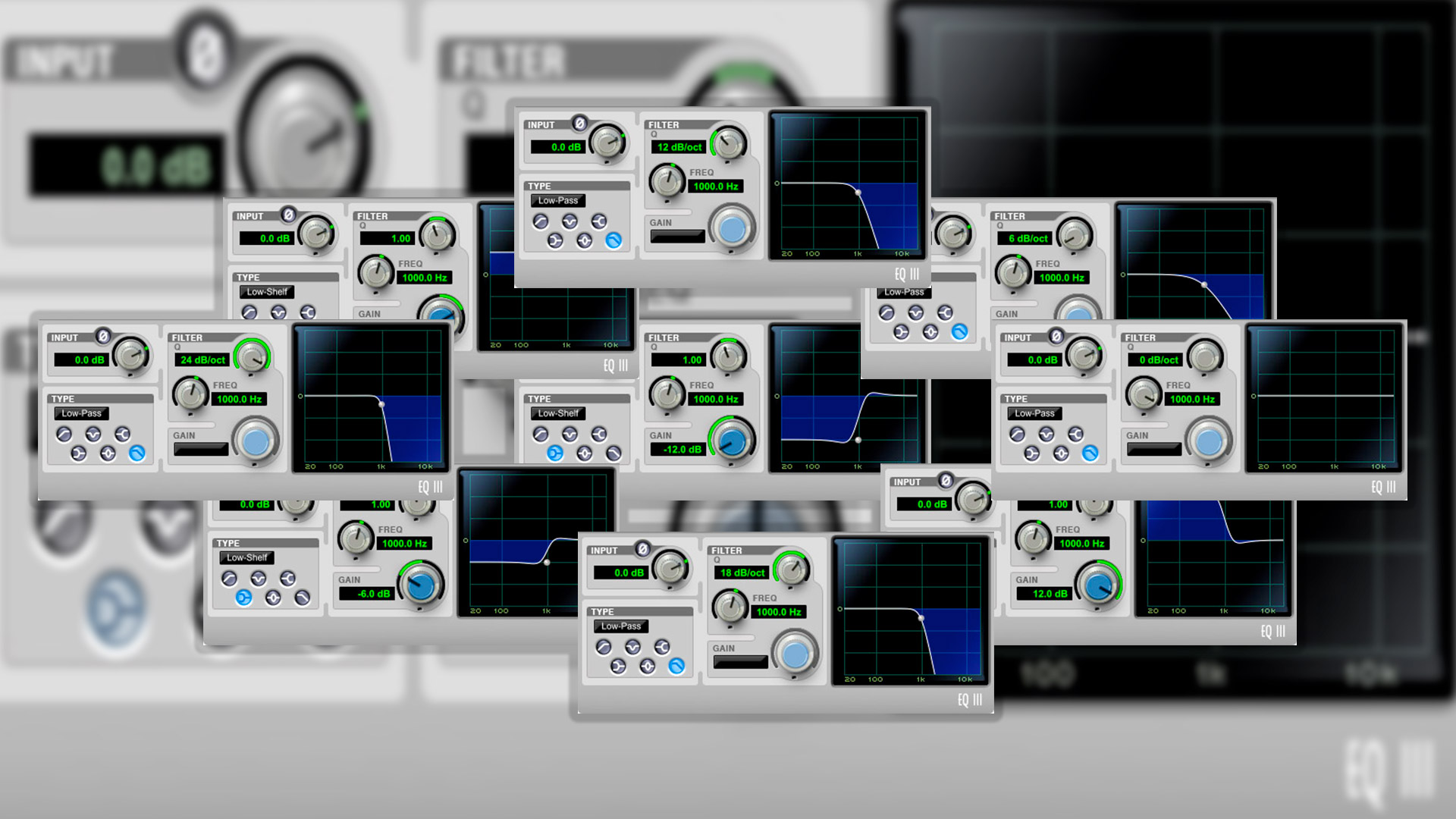What is the difference between EQ and filters? *With Audio*

Both EQ and filters alter the frequency response characteristics of a signal. But how are they different, and how should they be applied?
Let's start with baby steps. An audio signal consists of a range of frequencies from low (20 Hz) to high (20,000 Hz). Low frequencies represent low notes, high frequencies represent high notes and overtones. 'hertz' (Hz) means 'vibrations per second'. Note the difference in capitalisation between the full name of the unit and its abbreviation.
Often it is desirable to boost some frequencies and perhaps cut others in level. This might because there is a perceived problem with the signal, to enhance it, or to help it blend in with other signals better.
And the tools we use to do this are filters and equalizers.
Let's look at filters first...
There are five main types of filter: low-pass, high-pass, band-pass, band-stop and notch.
- A low-pass filter allows low frequencies to pass and attenuates (reduces) high frequencies.
- A high-pass filter allows high frequencies to pass and attenuates low frequencies.
- A band-pass filter allows mid-range frequencies to pass and attenuates low and high frequencies.
- A band-stop filter allows low and high frequencies to pass and attenuates mid-range frequencies.
- A notch filter is a band-stop filter that covers a very narrow range of frequencies.
Most commonly found are the low-pass and high-pass filters. Let's look at the low-pass filter because this is used in sound engineering and widely in subtractive synthesis too...
The low-pass filter has a 'cut-off frequency'. Below this frequency, everything is allowed through unaltered. This is called the 'pass band'. Above this frequency, the signal is progressively attenuated at higher and higher frequencies. This is called the 'stop band'.
Actually at the cut-off frequency, the signal is 3 decibels lower in level than frequencies in the pass band. Clearly there is a gradual transition between the pass band and the stop band.
In the stop band, a filter is said to have a 'slope'. A low pass filter doesn't cut off high frequencies completely. Above the cut-off frequency it attenuates them more and more as the frequency gets higher.
At a certain point above the cut-off frequency, the degree of attenuation will be 6 dB (for instance). An octave higher in frequency, the attenuation may be 12 dB.
We would say that this filter has a slope of 6 dB/octave, an octave being a doubling of frequency.
It is common to find filters with slopes of 6, 12, 18 and 24 dB/octave. Clearly, a steeper slope means a more pronounced filtering effect.
A typical low-pass filter will have a control for cut-off frequency, and may have a switch for slope.
Now for equalizers...
Equalizers come in three main types: low frequency, midrange, high frequency. There are more options and subdivisions, but I don't want to get too complicated here.
Let's look at a low-frequency (LF) EQ and see how it differs from a low-pass filter...
A well-specified LF EQ will have the following controls:
- Frequency
- Gain
- Bell/shelf
The frequency control sets the frequency at which the EQ will start to take effect. It will operate on a range of frequencies lower than this.
Gain sets the amount of cut or boost to be applied. Usually there is up to plus or minus 12 to 18 dB.
If the LF EQ is set to 'shelf' then as the frequency of the signal drops below that set by the frequency control, then the amount of cut or boost will increase, until it reaches a maximum value. Beyond that, it will stay the same.
If the LF EQ is set to 'bell' then its the same as above, except that the amount of cut or boost will return to zero at lower frequencies.
LF and HF EQ sections do have a feature very similar to slope, which is 'Q' or resonance, but you often don't get to control it. Some say that this is the factor that makes one EQ more 'musical' than another.
I'm sure that by now you want to hear the differences between all of these.
Well, I have stuck to the low frequency end, but I have a nice little demonstration of filters and EQ for you.
In the filters demo you can first hear the untreated track. Then after four bars a low-pass filter with a cutoff frequency of 1 kHz and a slope of 6 dB/octave is switched in. After four more bars the slope is increased to 12 dB/octave, then 18, then 24, and then the clean track to end.
A word of explanation. This track is low in level, around 12 dB below full scale. This is deliberate so that there is sufficient headroom for the LF boost in the EQ demo, so that you can compare all at the same original level. Here is the filters track...
As you can hear, filters can make a drastic difference to a track. This is just a demonstration by the way. I'm not saying that filters should be used in this way, just that this is what they sound like.
Here are the filter settings, in order...
Now for the EQ demo. This starts with the untreated track, then after four bars a low-frequency EQ section is switched in with a frequency setting of 1 kHz and a gain of -6 dB.
After four more bars the gain is set to -12 dB, then +6, then +12. Afterwards comes the clean track again.
As you can hear, the cut settings are reminiscent of the filter, but subtly different. And of course EQ offers the possibility of boost, where filters do not.








































